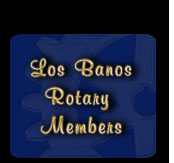




Los
Banos Rotary Club History
Speaker Hails Age Of "Automaticity"
We're in a revolution—awonder-button miracles. So says H. C. ful industrial revolution of push-Burbridge, head of the physics department at the Fresno State College. Speaking at the Rotary Club luncheon here Tuesday, Burbidge told of some of the miracles that has been brought with development of the microwave and the ultra utilization of electric horsepower to do man's work.
Going back only a comparatively few years, Burbridge said the first industrial revolution followed the invention of the steam engine—a mechanical device that for the first time displaced man and animal horsepower as a medium of power.
He gave the American inventor Eli Whitney credit for starting the second revolution—not by invention of his cotton gin, but by first step toward mass production, while filling a contract for 200 rifles for the U.S. Army, Previously Army rifles were a custom built job, each laboriously made by hand and no two exactly the same. The average contract for manufacture was 10. Whitney changed all that by mass producing each part, all exactly alike, before final assembly. Henry Ford was the first big manufacturer, Burbridge pointed out, to magnify the same principles in the building of the model T, and it was Ford who first concived assembly line production, wherein each worker added one part or performed on specialized task as the unit passed by on a moving platform.
Today, he said, is the day of automatation, or automaticity, with electric motors, push-button and X-ray controls performing the tasks of mankind with speed and exactness heretofore undreamed of. As an example, the speaker pointed out the beer industry, which has just developed a mechanical brain that uses X-ray to measure each can of beer within 30 drop variation, and automatically discard any can that is as much as 30 drops short. Also, the automotive industry which uses X-ray and microwave controls to further perfect manufacturing processes.
Burbridge pointed to today's grocery store shelf as another example of automatically, with cake, bisquick and other prepared flour mixes being exactly proportioned, mixed and packed in carload lots for the convenience of the American housewife.
Of especial interest to the business office world, Burbridge told something of the new electronic calculations and "memory" machines, which perform mathematical problems with unerring accuracy and unbelievable speed. For instance, one such machine is in use in a Livermore, California, atomic laboratory. Nicknamed the "maniac," the machine is capable of recording the telephone numbers of every one of the 40 million phones in the United States, and "remembering" with such accuracy that any one wanted number can be shown in about 5 thousandths of one second. By contrast to the modern electric calculator, he said that three men, suing this machine, could accomplish in three weeks what would require one man 45 years to accomplish with an electric calculator. He said the machine is finding many uses in today's world of business.
The speaker was introduced by program chairman Frank Peluso.
July 17, 1953
Los Banos Enterprise, Rotary Club 585 & Memorable Places Web Design of Los Banos


